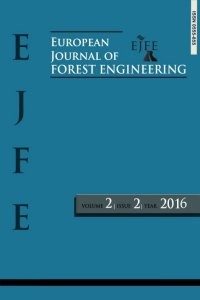Abstract
In Japan, soft and sandy soils and steep slopes were
native problems and usually caused difficulties in forest road construction. In
addition, there were many crushing zones in mountainous forested area, and
underground water often sprung out from stones and rocks in these crushing
zones. This underground water often caused road degradation and should be
drained. Some forest road retaining technologies had been introduced recently
for stabling spur roads. One is L-shaped steel retaining wall technology called
L-shaped mesh wall. It is easy to construct and underground water can be
drained easily. The other is reinforced soil wall using thinned logs and
geotextile called TK wall. In this study, the bearing capacity and usage of
these technologies were analyzed based on the points of terrain, bearing
capacity, and future possibility. L-shaped mesh wall was effective when applied
to cross the short section of crushing zone. TK wall was easy to construct on
steep slopes with narrow clearing width for roadway by its perpendicular
filling slope, and provided environmental friendly landscape with recovered
vegetation from the seed contained at surface as well as using thinned woods. Both
technologies made easier to construct spur roads on slopes with soft soils but
it was clarified that they needed appropriate drainage systems and their
regular maintenance for economical use.
References
- Ishikawa Prefecture Federation of Forest Owners’ Associations, 2011. TK wall Construction Method. http://www.ishikawa-moriren.jp/tkwall.pdf (Referred 17/1/2014)*
- Japanese Forestry Agency, 2010. Guideline of Constructing Forestry Operation Road. http://www.rinya.maff.go.jp/j/seibi/saisei/pdf/sinrinsagyoudou.pdf (Referred 7/3/2014) *
- Nippon Steel & Sumikin Metal Products Co., Ltd, 2011. L-shaped Mesh Wall. Catalog No. L532. 4p. *
- Oohashi, K., 2011. Forestry Operation Road - Road Network Planning and Route Location. Zenkoku-Ringyou-Kairyou-Fukyu-Kyokai. 121p. *
- Oohashi, K., 2012. How to Observe Mountain and Forest. Zenkoku-Ringyou-Kairyou-Fukyu-Kyokai. 136p. *
- Osaka National Government Building, 2005. Test Method by a Simple Bearing Capacity Measuring Instrument. http://www.kkr.mlit.go.jp/kingi/database/16/caspol_manual.pdf (Referred 21/8/2014) *
- Takahashi, H., Minami, Y., Yoshida, M., Sakai, H., 2015a. Relationships between reinforced soli wall and bearing capacity of forest road and management. Chubu Shinrin Kenkyu. 63:99-102. *
- Takahashi, H., Sakai, H., Usuda, H., Watada, T., Furukawa, K., 2015b. Constructing L-shaped steel retaining wall and its bearing capacity. Journal of the Japan Forest Engineering Society.30(2):79-84. **
- Takahashi, H., Sakurai, R., Sakai, H., 2014. Features of bearing capacity of spur road surfaces constructed by different methods. Journal of the Japan Forest Engineering Society. 29(1):31-36. **
- Tatsuoka, F., supervision. 2005. All of New Reinforced Soil Wall. Sougou Doboku Kenkyusho. 414p. * * In Japanese and titles were tentative translation by the authors. ** In Japanese with English summary.
Abstract
References
- Ishikawa Prefecture Federation of Forest Owners’ Associations, 2011. TK wall Construction Method. http://www.ishikawa-moriren.jp/tkwall.pdf (Referred 17/1/2014)*
- Japanese Forestry Agency, 2010. Guideline of Constructing Forestry Operation Road. http://www.rinya.maff.go.jp/j/seibi/saisei/pdf/sinrinsagyoudou.pdf (Referred 7/3/2014) *
- Nippon Steel & Sumikin Metal Products Co., Ltd, 2011. L-shaped Mesh Wall. Catalog No. L532. 4p. *
- Oohashi, K., 2011. Forestry Operation Road - Road Network Planning and Route Location. Zenkoku-Ringyou-Kairyou-Fukyu-Kyokai. 121p. *
- Oohashi, K., 2012. How to Observe Mountain and Forest. Zenkoku-Ringyou-Kairyou-Fukyu-Kyokai. 136p. *
- Osaka National Government Building, 2005. Test Method by a Simple Bearing Capacity Measuring Instrument. http://www.kkr.mlit.go.jp/kingi/database/16/caspol_manual.pdf (Referred 21/8/2014) *
- Takahashi, H., Minami, Y., Yoshida, M., Sakai, H., 2015a. Relationships between reinforced soli wall and bearing capacity of forest road and management. Chubu Shinrin Kenkyu. 63:99-102. *
- Takahashi, H., Sakai, H., Usuda, H., Watada, T., Furukawa, K., 2015b. Constructing L-shaped steel retaining wall and its bearing capacity. Journal of the Japan Forest Engineering Society.30(2):79-84. **
- Takahashi, H., Sakurai, R., Sakai, H., 2014. Features of bearing capacity of spur road surfaces constructed by different methods. Journal of the Japan Forest Engineering Society. 29(1):31-36. **
- Tatsuoka, F., supervision. 2005. All of New Reinforced Soil Wall. Sougou Doboku Kenkyusho. 414p. * * In Japanese and titles were tentative translation by the authors. ** In Japanese with English summary.
Details
| Subjects | Engineering |
|---|---|
| Journal Section | Research Articles |
| Authors | |
| Publication Date | November 21, 2016 |
| Published in Issue | Year 2016 Volume: 2 Issue: 2 |

The works published in European Journal of Forest Engineering (EJFE) are licensed under a Creative Commons Attribution-NonCommercial 4.0 International License.


